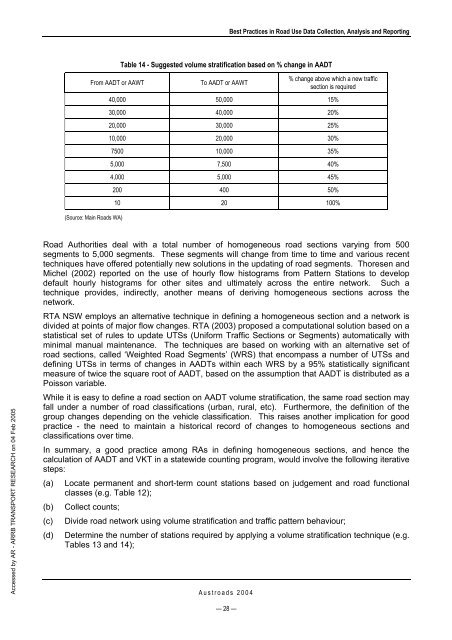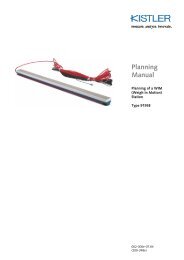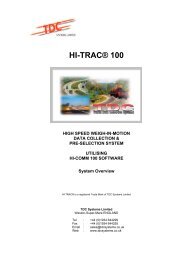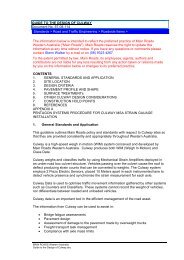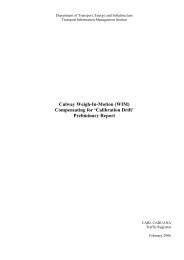AP-G84/04 Best practice in road use data collection, analysis ... - WIM
AP-G84/04 Best practice in road use data collection, analysis ... - WIM
AP-G84/04 Best practice in road use data collection, analysis ... - WIM
Create successful ePaper yourself
Turn your PDF publications into a flip-book with our unique Google optimized e-Paper software.
Accessed by AR - ARRB TRANSPORT RESEARCH on <strong>04</strong> Feb 2005<br />
Aust<strong>road</strong>s 20<strong>04</strong><br />
— 28 —<br />
<strong>Best</strong> Practices <strong>in</strong> Road Use Data Collection, Analysis and Report<strong>in</strong>g<br />
Table 14 - Suggested volume stratification based on % change <strong>in</strong> AADT<br />
From AADT or AAWT To AADT or AAWT<br />
(Source: Ma<strong>in</strong> Roads WA)<br />
% change above which a new traffic<br />
section is required<br />
40,000 50,000 15%<br />
30,000 40,000 20%<br />
20,000 30,000 25%<br />
10,000 20,000 30%<br />
7500 10,000 35%<br />
5,000 7,500 40%<br />
4,000 5,000 45%<br />
200 400 50%<br />
10 20 100%<br />
Road Authorities deal with a total number of homogeneous <strong>road</strong> sections vary<strong>in</strong>g from 500<br />
segments to 5,000 segments. These segments will change from time to time and various recent<br />
techniques have offered potentially new solutions <strong>in</strong> the updat<strong>in</strong>g of <strong>road</strong> segments. Thoresen and<br />
Michel (2002) reported on the <strong>use</strong> of hourly flow histograms from Pattern Stations to develop<br />
default hourly histograms for other sites and ultimately across the entire network. Such a<br />
technique provides, <strong>in</strong>directly, another means of deriv<strong>in</strong>g homogeneous sections across the<br />
network.<br />
RTA NSW employs an alternative technique <strong>in</strong> def<strong>in</strong><strong>in</strong>g a homogeneous section and a network is<br />
divided at po<strong>in</strong>ts of major flow changes. RTA (2003) proposed a computational solution based on a<br />
statistical set of rules to update UTSs (Uniform Traffic Sections or Segments) automatically with<br />
m<strong>in</strong>imal manual ma<strong>in</strong>tenance. The techniques are based on work<strong>in</strong>g with an alternative set of<br />
<strong>road</strong> sections, called ‘Weighted Road Segments’ (WRS) that encompass a number of UTSs and<br />
def<strong>in</strong><strong>in</strong>g UTSs <strong>in</strong> terms of changes <strong>in</strong> AADTs with<strong>in</strong> each WRS by a 95% statistically significant<br />
measure of twice the square root of AADT, based on the assumption that AADT is distributed as a<br />
Poisson variable.<br />
While it is easy to def<strong>in</strong>e a <strong>road</strong> section on AADT volume stratification, the same <strong>road</strong> section may<br />
fall under a number of <strong>road</strong> classifications (urban, rural, etc). Furthermore, the def<strong>in</strong>ition of the<br />
group changes depend<strong>in</strong>g on the vehicle classification. This raises another implication for good<br />
<strong>practice</strong> - the need to ma<strong>in</strong>ta<strong>in</strong> a historical record of changes to homogeneous sections and<br />
classifications over time.<br />
In summary, a good <strong>practice</strong> among RAs <strong>in</strong> def<strong>in</strong><strong>in</strong>g homogeneous sections, and hence the<br />
calculation of AADT and VKT <strong>in</strong> a statewide count<strong>in</strong>g program, would <strong>in</strong>volve the follow<strong>in</strong>g iterative<br />
steps:<br />
(a) Locate permanent and short-term count stations based on judgement and <strong>road</strong> functional<br />
classes (e.g. Table 12);<br />
(b) Collect counts;<br />
(c) Divide <strong>road</strong> network us<strong>in</strong>g volume stratification and traffic pattern behaviour;<br />
(d) Determ<strong>in</strong>e the number of stations required by apply<strong>in</strong>g a volume stratification technique (e.g.<br />
Tables 13 and 14);


